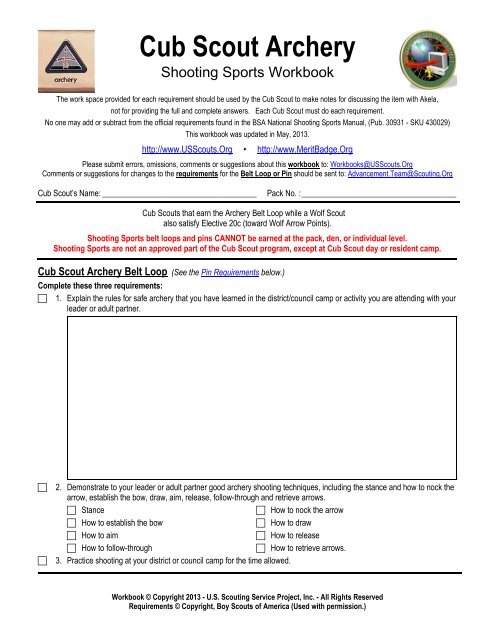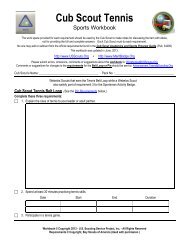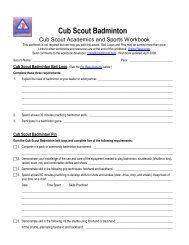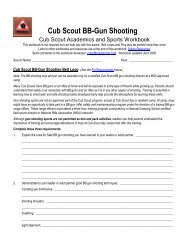Cub Scout Archery Worksheet - Merit Badge Research Center
Cub Scout Archery Worksheet - Merit Badge Research Center
Cub Scout Archery Worksheet - Merit Badge Research Center
You also want an ePaper? Increase the reach of your titles
YUMPU automatically turns print PDFs into web optimized ePapers that Google loves.
<strong>Cub</strong> <strong>Scout</strong> <strong>Archery</strong>Shooting Sports WorkbookThe work space provided for each requirement should be used by the <strong>Cub</strong> <strong>Scout</strong> to make notes for discussing the item with Akela,not for providing the full and complete answers. Each <strong>Cub</strong> <strong>Scout</strong> must do each requirement.No one may add or subtract from the official requirements found in the BSA National Shooting Sports Manual, (Pub. 30931 - SKU 430029)This workbook was updated in May, 2013.http://www.US<strong>Scout</strong>s.Org • http://www.<strong>Merit</strong><strong>Badge</strong>.OrgPlease submit errors, omissions, comments or suggestions about this workbook to: Workbooks@US<strong>Scout</strong>s.OrgComments or suggestions for changes to the requirements for the Belt Loop or Pin should be sent to: Advancement.Team@<strong>Scout</strong>ing.Org<strong>Cub</strong> <strong>Scout</strong>’s Name: ______________________________________Pack No. :______________________________________<strong>Cub</strong> <strong>Scout</strong>s that earn the <strong>Archery</strong> Belt Loop while a Wolf <strong>Scout</strong>also satisfy Elective 20c (toward Wolf Arrow Points).Shooting Sports belt loops and pins CANNOT be earned at the pack, den, or individual level.Shooting Sports are not an approved part of the <strong>Cub</strong> <strong>Scout</strong> program, except at <strong>Cub</strong> <strong>Scout</strong> day or resident camp.<strong>Cub</strong> <strong>Scout</strong> <strong>Archery</strong> Belt Loop (See the Pin Requirements below.)Complete these three requirements: 1. Explain the rules for safe archery that you have learned in the district/council camp or activity you are attending with yourleader or adult partner. 2. Demonstrate to your leader or adult partner good archery shooting techniques, including the stance and how to nock thearrow, establish the bow, draw, aim, release, follow-through and retrieve arrows. Stance How to nock the arrow How to establish the bow How to draw How to aim How to release How to follow-through How to retrieve arrows. 3. Practice shooting at your district or council camp for the time allowed.Workbook © Copyright 2013 - U.S. <strong>Scout</strong>ing Service Project, Inc. - All Rights ReservedRequirements © Copyright, Boy <strong>Scout</strong>s of America (Used with permission.)
<strong>Cub</strong> <strong>Scout</strong> <strong>Archery</strong><strong>Cub</strong> <strong>Scout</strong>'s Name: ________________________<strong>Cub</strong> <strong>Scout</strong> <strong>Archery</strong> PinEarn the <strong>Cub</strong> <strong>Scout</strong> <strong>Archery</strong> belt loop, and complete five of the following requirements: 1. Explain the parts of a bow and demonstrate how to string the bowstring in a proficient manner. 2. Demonstrate how to properly use archery equipment, including arm guards, finger tabs, and quivers and explain aboutproper clothing. 3. Develop proficient shooting techniques by practicing for three hours.<strong>Cub</strong> <strong>Scout</strong> <strong>Archery</strong> Workbook Page 2 of 4
<strong>Cub</strong> <strong>Scout</strong> <strong>Archery</strong><strong>Cub</strong> <strong>Scout</strong>'s Name: ________________________ 4. Learn the correct scoring techniques for target archery. 5. Make a poster that emphasizes the four whistle codes. 6. Draw to scale or set up an archery range. 7. Shoot 30 arrows from a distance of 30 feet at a target and score at least 50 points, or shoot 30 arrows from a distance of90 feet and score at least 30 points. 8 Help make a type of target for the camp archery range. 9. Show how to put away and properly store archery equipment. 10. Tell five facts about an archer in history or literature.1.2.3.4.5.Requirement resources can be found here:http://www.meritbadge.org/wiki/index.php/<strong>Cub</strong>_<strong>Scout</strong>_<strong>Archery</strong>#Requirement resources<strong>Cub</strong> <strong>Scout</strong> <strong>Archery</strong> Workbook Page 3 of 4
Attachment – (NOTE: It is not necessary to print this page.)Important excerpts from the ‘Guide To Advancement’, No. 33088:Effective January 1, 2012, the ‘Guide to Advancement’ (which replaced the publication ‘Advancement Committee Policies and Procedures’) isnow the official Boy <strong>Scout</strong>s of America source on advancement policies and procedures.[ Inside front cover, and 5.0.1.4 ] — Unauthorized Changes to Advancement ProgramNo council, committee, district, unit, or individual has the authority to add to, or subtract from, advancement requirements.(There are limited exceptions relating only to youth members with disabilities. For details see section 10, “Advancement for MembersWith Special Needs”.)[ Inside front cover, and 7.0.1.1 ] — The ‘Guide to Safe <strong>Scout</strong>ing’ AppliesPolicies and procedures outlined in the ‘Guide to Safe <strong>Scout</strong>ing’, No. 34416, apply to all BSA activities, including those related toadvancement and Eagle <strong>Scout</strong> service projects. [Note: Always reference the online version, which is updated quarterly.][ 4.1.0.3 ] ] — Who Approves <strong>Cub</strong> <strong>Scout</strong> Advancement?A key responsibility for den leaders is to implement the core den meeting plans as outlined in the Den & Pack Meeting ResourceGuide, No. 34409. For Wolf, Bear, and Webelos advancement, den leaders take the lead in approving requirements, though theirassistants, and also parents who help at meetings, may be asked to play the role of “Akela” and assist. Parents sign for requirementsthat, according to meeting plans and instructions in the handbooks, take place at home. For the Bobcat trail and Tiger <strong>Cub</strong>achievements, parents (or adult partners) should sign in the boy’s handbook; the den leader then approves as progress is recordedin the den’s advancement record.[ 4.1.0.4 ] — “Do Your Best”Advancement performance in <strong>Cub</strong> <strong>Scout</strong>ing is centered on its motto: “Do Your Best.” When a boy has done this—his very best—thenregardless of the requirements for any rank or award, it is enough; accomplishment is noted. This is why den leaders, assistants, andparents or guardians are involved in approvals. Generally they know if effort put forth is really the <strong>Cub</strong> <strong>Scout</strong>’s best.[ 4.1.2.2 ] — <strong>Cub</strong> <strong>Scout</strong> Academics and Sports ProgramMore than just a recognition opportunity, this program develops new skills, improves those existing, and otherwise enriches <strong>Cub</strong><strong>Scout</strong>ing. Details can be found in the <strong>Cub</strong> <strong>Scout</strong> Academics and Sports Program Guide, No. 34299. Activities include subjects likescience, video games, collecting, and chess; and sports such as baseball, skateboarding, and table tennis. Each has two levels—abelt loop and a pin. Belt loops, which can be earned more than once, are awarded when each of three requirements is met. <strong>Cub</strong><strong>Scout</strong>s may then continue with additional requirements and earn the pin. <strong>Archery</strong> and BB gun shooting are included, but can only beconducted at a council presented activity with certified supervisors.Additional notes of interest:BSA shooting sports restrictions:Tiger <strong>Cub</strong>s, <strong>Cub</strong> <strong>Scout</strong>s, and Webelos <strong>Scout</strong>s may complete requirements for Belt loops and pins for <strong>Archery</strong> and BB-Gun Shootingonly in <strong>Cub</strong> <strong>Scout</strong>/Webelos <strong>Scout</strong> day camps or resident camps, in council-managed family camping programs, or at councilactivities where there is properly trained supervision, and all guidelines for BSA shooting sports are implemented.Shooting Sports belt loops and pins CANNOT be earned at the pack, den, or individual level.Shooting Sports are not an approved part of the <strong>Cub</strong> <strong>Scout</strong> program, except at <strong>Cub</strong> <strong>Scout</strong> day or resident camp.Councils may provide extra opportunities for a boy and his adult partner to continue qualifying for a pin after the council campexperience is over. However, a certified range officer must be present for shooting credits to be valid. The Shooting Sports beltloops and pins can only be awarded by a BSA range-trained shooting-sports director at a BSA approved range. Tiger <strong>Cub</strong>s mustwork with their parents or adult partners. Parents and partners do not earn loops or pins.“Akela” (Pronounced “Ah-KAY-la”) — Title of respect used in <strong>Cub</strong> <strong>Scout</strong>ing—any good leader is Akela. Akela is also the leader andguide for <strong>Cub</strong> <strong>Scout</strong>s on the advancement trail. The name comes from Rudyard Kipling's Jungle Book. (See "Law of the Pack.") “Law of the Pack” — The <strong>Cub</strong> <strong>Scout</strong> follows Akela.The <strong>Cub</strong> <strong>Scout</strong> helps the pack go.The pack helps the <strong>Cub</strong> <strong>Scout</strong> grow.The <strong>Cub</strong> <strong>Scout</strong> gives goodwill.Page 4 of 4








